
From 1 September 2008, there will be major changes in how principal contractors and sub-contractors in the construction industry account for VAT. Principal contractors and sub-contractors will need to know how to operate the new system and be prepared for the change.
The new system applies to principal contractors and sub-contractors involved in construction operations to which Relevant Contracts Tax (RCT) applies (but excluding haulage for hire).
RCT applies when a principal contractor is obliged to deduct tax @35% from payments to a sub-contractor or would have to do so but for the fact that the principal contractor holds a Relevant Payments Card (RCT 47) for that sub-contractor. Public bodies, including Local Authorities, who receive construction services are principal contractors for RCT purposes and the person who contracts to provide such services to a public body is regarded as a sub-contractor.
Prior to 1 September 2008 the charge that a sub-contractor makes to a principal contractor includes VAT on that service. The principal pays the sub-contractor and the sub-contractor passes on the VAT to the Revenue Commissioners.
From 1 September 2008 the charge the sub-contractor makes to a principal contractor does not include VAT. Instead the principal contractor calculates the VAT on the amount charged by the sub-contractor and pays the VAT directly to the Revenue Commissioners through his/her VAT return.
No. VAT on construction services that are not subject to RCT will continue to be taxed under the normal VAT system. For example, a builder who builds an extension for a private individual, or an electrician who installs a new alarm system in a shop should charge and account for VAT on the supply. The reverse charge does not apply to these supplies.
As many construction service providers are involved in different types of contracts (e.g. a builder may be acting as principal in one contract, as a sub-contractor in another and supplying services that are not subject to RCT under another contract) it is important to be aware of how the system operates.
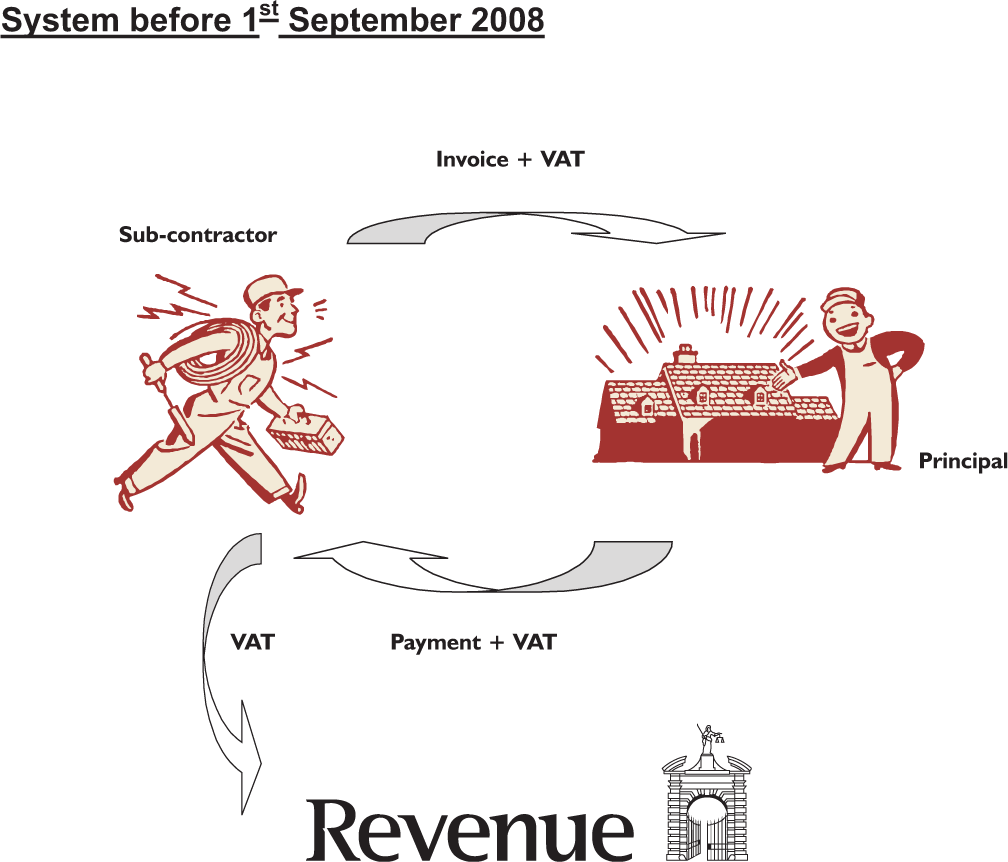
The position up to 1 September 2008 is as follows:
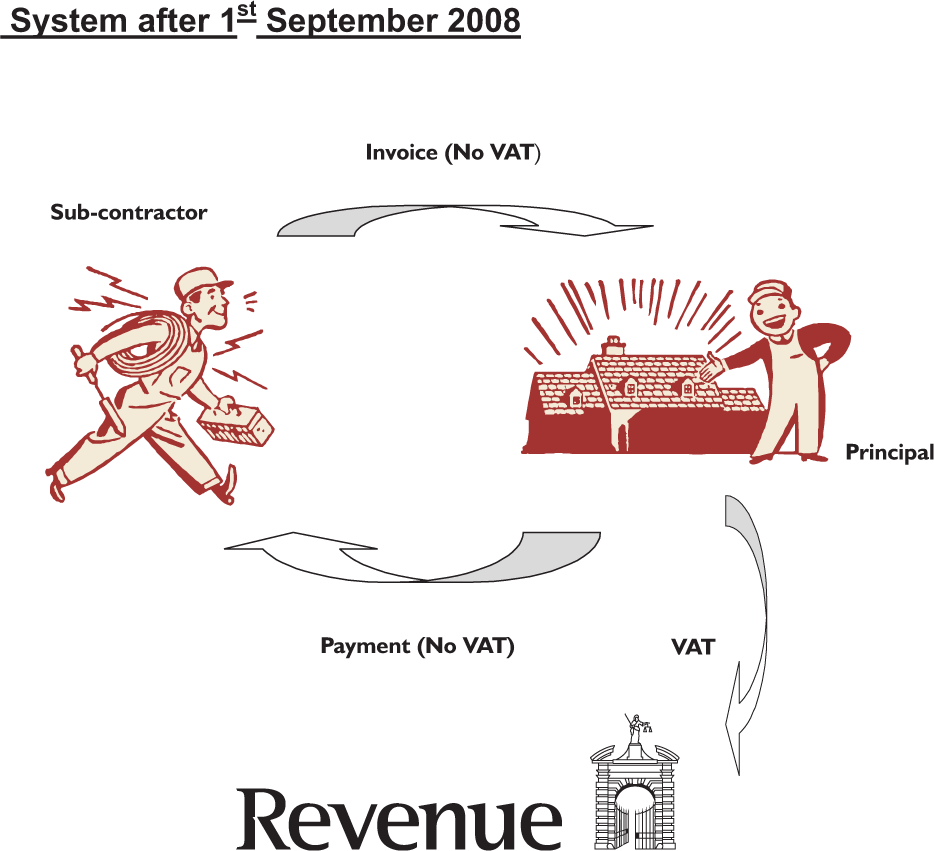
From the 1st September 2008 the principal accounts for the VAT on services received from a sub-contractor under what is known as the reverse charge.
The following examples illustrate the effects of the change. The services in question are invoiced in September/October 2008.
Example 1
A Ltd
A Ltd is renovating a factory building for a manufacturing company. A Ltd invoices the manufacturing company in October 2008 as follows:
Construction services |
€740,740 |
VAT @13.5% |
€100,000 |
Total |
€840,740 |
These services do not come within the reverse charge since A Ltd is not a sub-contractor to the manufacturing company for RCT purposes.
B, a building contractor, supplies services to A Ltd. A Ltd is the principal contractor and B is the sub-contractor. A Ltd does not hold a Relevant Payments Card for B.
B incurred €13,000 VAT on purchases in September/October 2008 for the purposes of his business.
B charges A Ltd €600,000 in September 2008 for the building services. B does not charge any VAT on this amount. A Ltd accounts for the VAT on the construction services from B. VAT chargeable on the services @13.5% = €81,000.
As the construction services provided by the sub-contractor to the principal were invoiced during September/October 2008 the VAT on these services is accounted for by reverse charge.
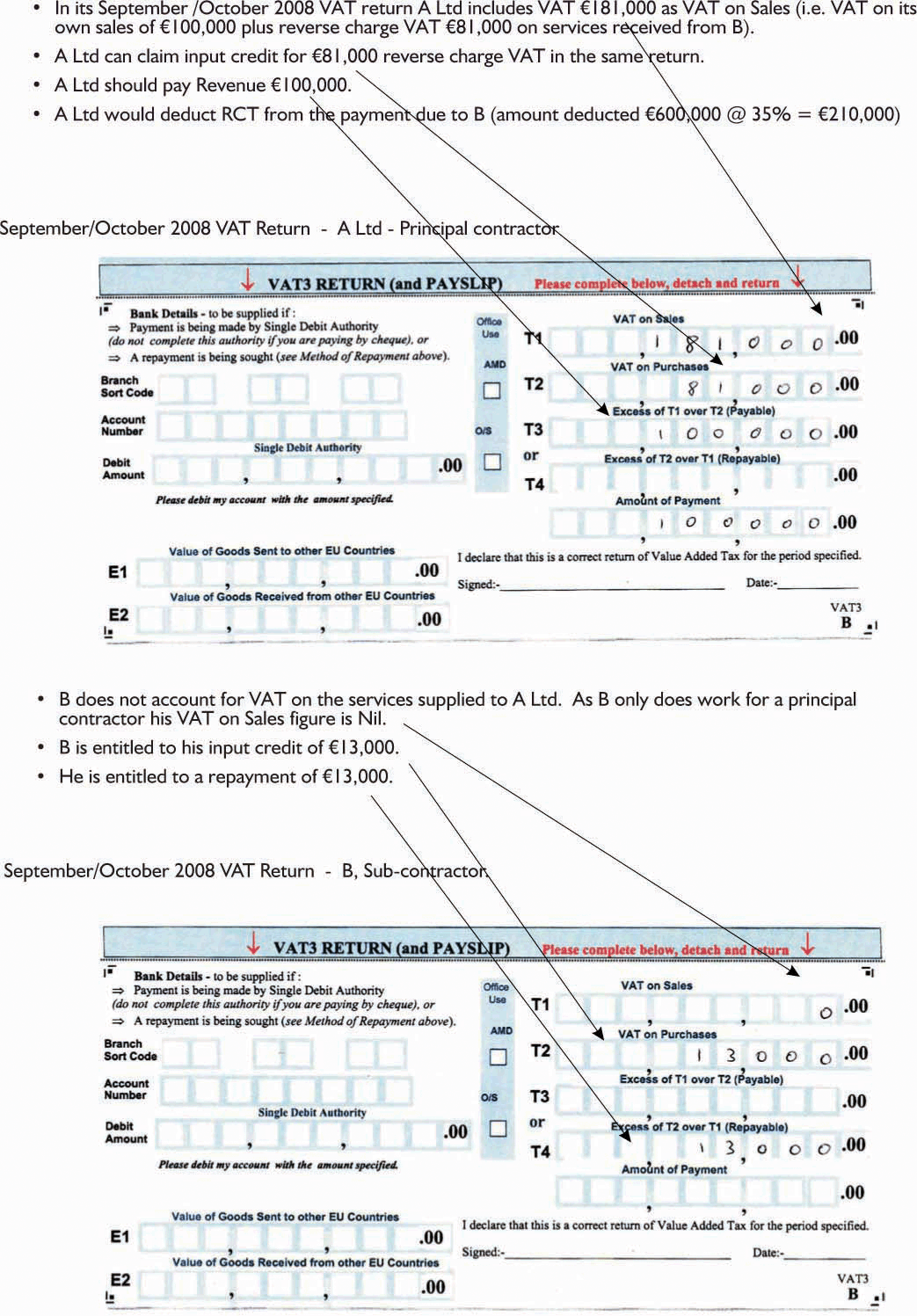
Example 2
The facts are as in Example 1 but B also does building work for private householders in September/October 2008. RCT does not apply to this work. He accounts for VAT €70,000 in respect of these supplies.
C is a subcontractor, who has his own electrical business, but who does occasional work for B. C’s only supplies in this period are made to B. C is registered for VAT. He charges B €48,000. C has incurred VAT of €1,000 for which he is entitled to input credit.
B is a principal contractor in respect of the electrical services he receives from C. A Ltd: See Example 1.
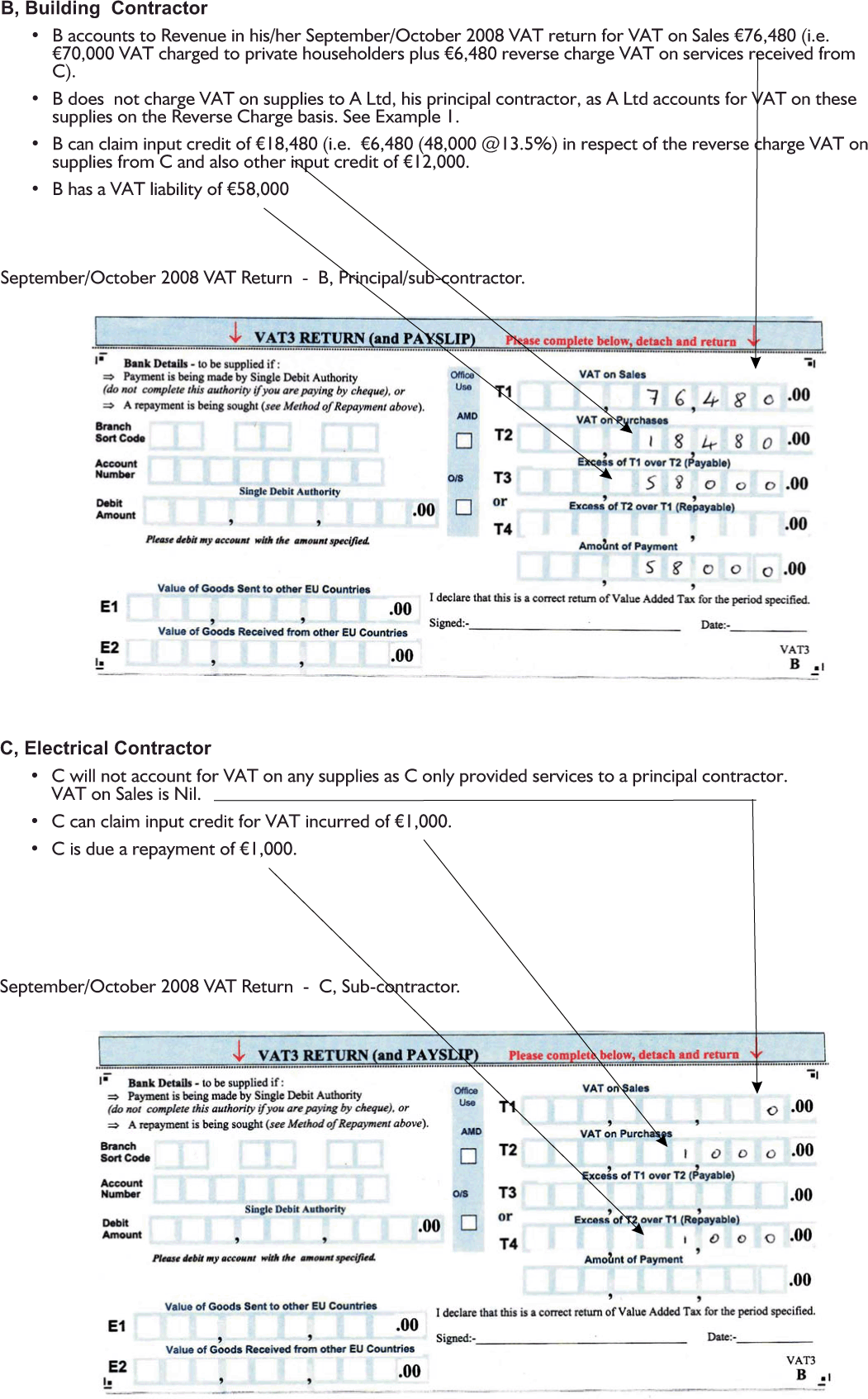
From 1 September 2008 Government Departments, Local Authorities and Public bodies who are principal contractors for the purposes of RCT and who receive construction services must be registered for VAT. They should no longer pay any VAT over to sub-contractors and instead should account for the VAT on services received from sub-contractors directly to Revenue through their VAT return. As these bodies are generally not carrying on any taxable activities they would not normally be entitled to claim any deduction for VAT incurred.
Example 3
A County Council contracts for the building of a road with D Ltd which charges €1,000,000 for its services in September /October 2008. For RCT purposes the County Council is a principal contractor and the construction company is a sub-contractor.
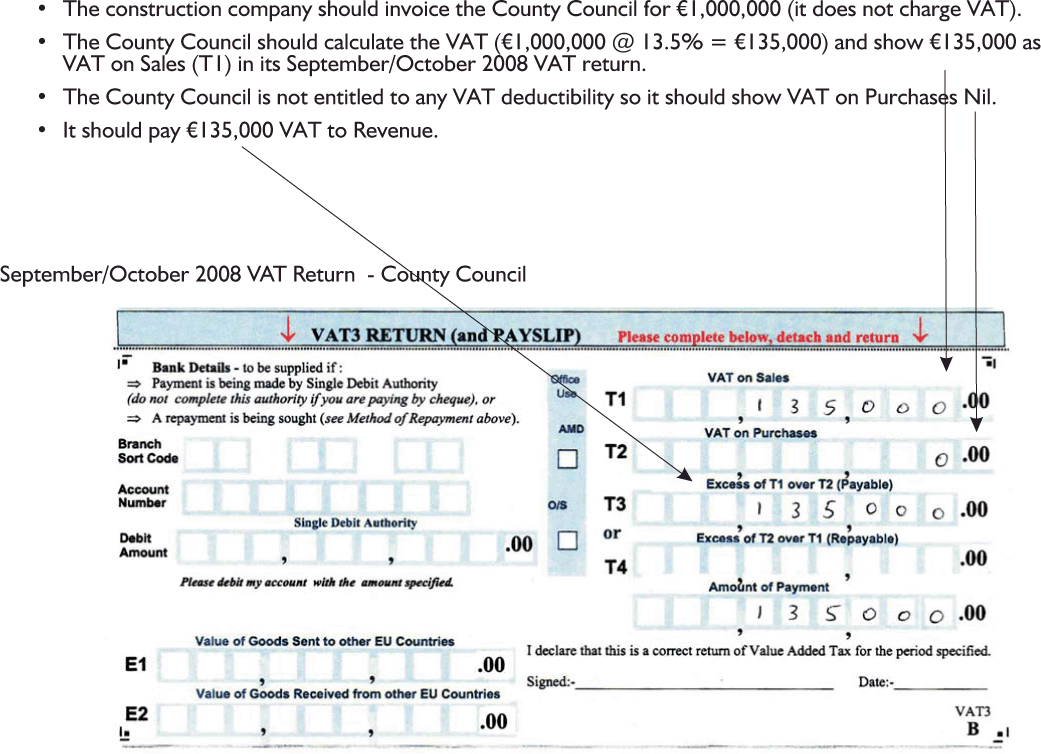
Where the VAT exclusive cost of goods supplied in the course of providing a service exceeds two thirds of the total VAT exclusive charge for the supply, the rate of VAT applicable is the rate that applies to the goods.
The two-thirds rule does not apply where the reverse charge applies.
The reverse charge will not apply to a supply of goods where that supply is not part of a construction service that is subject to RCT
The new system will apply with effect from 1 September 2008. It will not apply to any invoice that is issued before that date or that should have been issued before that date.
Both principal contractors and sub-contractors should ensure that their records and accounting systems can deal with the new system.
A sub-contractor who is established outside the State, and whose only supplies in the State are to principals, is no longer required to be VAT registered in the State. S/he will however need to register for VAT for the purposes of claiming any refund of VAT. A sub-contractor who is established outside the State but who also provides construction services to customers other than principal contractors must register for VAT irrespective of the level of his/her turnover.
Further information is also available on the Revenue web site (www.revenue.ie.)
1 If agreed by both the principal contractor and the sub-contractor the principal may issue the invoice.
2 In the case of a payment in advance of completion of the supply, the principal will include the VAT on the payment in its VAT return for the period in which the payment is made.
3 Principal contractor for RCT purposes includes Local Authorities, Government Departments and boards established by or under statute. Many of these bodies would not be entitled to VAT input credit.